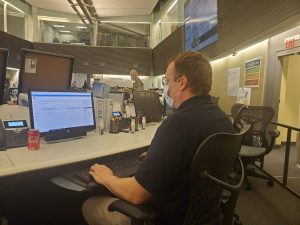Typically, Fermilab employee Keenan Newton spends his days managing Fermilab’s main content management platforms and his nights and weekends as a volunteer firefighter. Now he’s arranged his schedule to serve the Illinois Emergency Management Agency, volunteering his personal time to help people during the current pandemic and responding to hazardous situations while based at the State Emergency Operations Center in Springfield. He performs this work while continuing his full-time work as Fermilab Content Management Group lead.
Below is his account of what it’s like to serve the public as a part of the Situation Unit in the Illinois Incident Management Team.

Keenan Newton is on call at the Illinois State Emergency Operations Center. Photo: Rusty Tanton, Illinois Emergency State Agency
As a volunteer firefighter, I am very involved with public safety in my community. I get to learn many specialties such as hazardous materials technician work, rope operations and even instruction. One of the specialties I got involved in is incident management, specifically as a planning and situational unit leader. As I started to take FEMA classes for all-hazards incident management, I was invited to join a statewide volunteer team of incident managers, the Illinois Incident Management Team, which supports incident management duties at the county, state and national levels.
When the state of Illinois started activating resources to assist with managing the COVID-19 incident, it quickly found out that its internal resources were short since many individuals were already assisting at a more local level. As a result, the state reached out to the Illinois Incident Management Team to request help with planning, logistics and situation unit leader positions. I offered my assistance on the weekends, and I have been supporting the Situation Unit, which collects data from the various functional groups and summarizes it for the director of the Illinois Emergency Management Agency. The IEMA director then briefs the governor, who uses information from these briefings for his daily 2:30 p.m. public address.

This shows the main meeting room at the State Emergency Operations Center in Springfield, Illinois. Photo: LVD Architecture
Following Nigel Lockyer’s March 24 all-hands meeting, during which he said to bubble up any opportunities to assist in mitigating this pandemic, I requested the ability to work remotely from the State Emergency Operations Center in Springfield. Generally, the work is sporadic throughout the day, and since I just hang out in a hotel room in the evenings, I can work on lab tasks there while being close to the action in Springfield as needed. On average, I put in five hours of lab work during normal business hours and three additional hours in the evening, thus minimizing the impact to lab activities while I am assisting the SEOC.
One of my key accomplishments is to have introduced Microsoft Teams, a collaborative software tool, to the SEOC. The state had just procured the licenses but had not yet implemented Teams. Using this software has been a game changer for us in the Situation Unit — it condensed our daily process for compiling and submitting our daily report from three-and-a-half hours to only two-and-a-half hours. With the success of using Microsoft Teams within the Situation Unit, the SEOC management has decided to implement Microsoft Teams throughout the Illinois Emergency Management Agency to manage the entire COVID-19 pandemic response. My experience at the lab with both Teams and SharePoint has helped me to apply much of what I learned to streamline and improve the information flow at the SEOC and, ultimately, to the Illinois governor so he has the latest available information.



